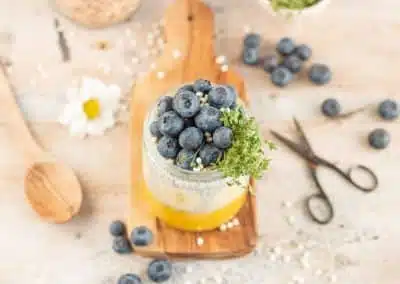Mango-Chai-Pudding
This breakfast idea combines all my favorite components: chai tea and mango! The chai tea and it’s spices give the pudding a sweet taste, so it’s even great without any without sugar. The ripe mango gives the pudding a fruity note. A great refreshing mix for the office and the hot summer days. Who else is a chai tea fan?
LOW-HISTAMINE
LACTOSE-FREE
GLUTEN-FREE
This breakfast idea combines all my favorite components: chai tea and mango! The chai tea and it’s spices give the pudding a sweet taste, so it’s even great without any without sugar. The ripe mango gives the pudding a fruity note. A great refreshing mix for the office and the hot summer days. Who else is a chai tea fan?
The ingredients can be adjusted as usual depending on your food intolerance. You can exchange the mango with papaya. Papaya contains digestive ingredients. Instead of natural yoghurt, you can also try this recipe with coconut yoghurt. It is naturally lactose-free, but still contains gut health-promoting lactobacilli.
Try it and show me your summery pudding creation on Instagram under the hashtag #bauchgeschichten!
Preparation time in min: 15
Calories per serving: 330
Ingredients (for 2 servings):
-
250 ml cold Chai tea
-
3 tbsp chia seed
-
1 mango; or: papaya
-
100 g yoghurt, lactose-free
-
1 tsp honey
-
optional for garnish: blueberries, banana
Preparation:
- Mix chia seeds with cold tea and let it soak in the fridge for about 10 minutes.
-
In the meantime, wash mango, peel and cut into small pieces. Then puree and put in a bowl or glass.
-
Mix the chia seed pudding with yoghurt and honey and layer into a bowl or glass.
- Now garnish the mango-chai-pudding with blueberries and banana.
Bon Appetit!
About me

Hello, my name is Dominika!
I am a nutritionist and since few years I am specialized in the field of “intestinal health”. Enjoy browsing here!
Follow me
Newsletter
& get my free e-book!

Frequently asked questions
I tried everything. But it is best not to eat at all. Do I take the strain off my gut?
In order to maintain an adequate supply of nutrients, to build up a rich microbiota as well as holistic health, a regular and symptom-oriented diet is necessary. The intestine and its great population need the right foods. Get a professional support along your way and always be patient. Exchange your ideas and wishes with your nutritionist. Or if you need some help, just don’t hesitate to contact me via the form.
I have no identified intolerances. Why do I still not tolerate fresh dairy products or fiber-rich foods?
Fresh dairy products contain higher levels of probiotics than usual, so they can briefly lead to lactose intolerance-like symptoms. The same is true for fiber-rich foods containing prebiotics. The intestine simply has to get used to the new population. Initially, you can relieve your stomach with a combination of vegetables and vegetable oils (such as linseed oil).
Cabbage, beans or fiber are bloating. Is there anything I can do against it?
A varied diet is important, including healthy fats. These relieve the intestine by ensuring that the food stays in the stomach for a longer time. Therefore always combine the meals with vegetable fats. But watch out – also the amount is important. Furthermore, frozen cabbage or beans are normally leading to less bloating.
You may like these posts too
Folge mir auf
Datenschutz | AGB | Impressum | Kontakt





0 Kommentare